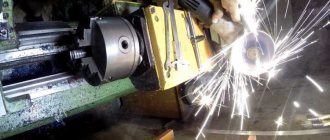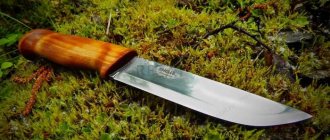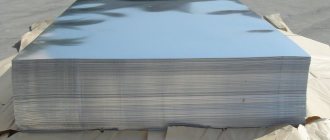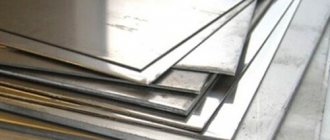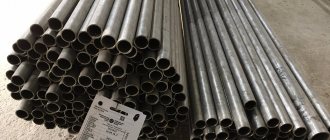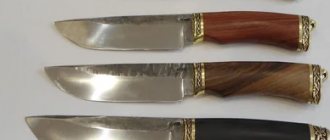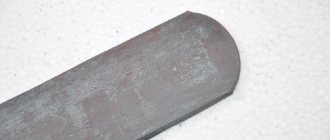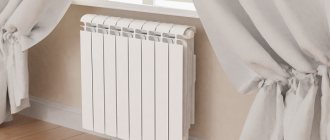Brass and stainless steel occupy a strong position in industrial production and are used in almost all areas and industries. In order to answer the question: which is better - brass or stainless steel (or, as it is also called, stainless steel) , you must first consider in detail the mechanical properties, strengths and weaknesses of each material separately. Only by visually comparing and evaluating all the advantages and disadvantages can you answer the question - which is better: brass or stainless steel , which we will try to do in our article.
TYPES OF STAINLESS STEEL
Stainless steel can be obtained by improving ordinary steel, as a result of enhancing its properties by adding impurities of other metals. Most often, the following reinforcing components are used: copper, nickel, chromium, manganese, titanium, sulfur, silicon and some others. Despite the many options for impurities, it is the percentage of chromium that is fundamental and determines the presence of certain properties of stainless steel. Based on the chromium content in the composition, it is customary to distinguish between five main types of stainless steel.
Austenitic steels. They contain at least 20% chromium and 4.5% nickel.
Duplex steels. Their chromium content reaches 25%, 1.5% nickel and a slight admixture of nitrogen.
Ferritic steels. Up to 29% chromium is allowed in their composition.
Martensitic steels. Their chromium content is insignificant, no more than 13%, and nickel maximum 4%.
Multicomponent steels. Minimal amounts of chromium and nickel and include a wide range of other enhancing impurities.
Hard alloy
- Alloys based on tungsten carbide and cobalt as a binder are designated VK.
- Alloys based on tungsten carbide with the addition of titanium carbide and cobalt as a binder are designated TK.
- Alloys based on tungsten carbide with the addition of titanium and tantalum carbide and cobalt as a binder are designated TTK.
Cutting speed v < 200-250 m/min; maximum cutting temperature - t = 1200-1300°C. Designations - T5K10, T15K6, VK8, VK6. Harmful impurities in steel - sulfur, gases. Useful impurities in steel are manganese and silicon. Defects - flakes, hairs, non-metallic inclusions.
PROPERTIES OF STAINLESS STEEL
So which is better: brass or stainless steel ? Let's look at the positive properties of stainless steel:
- High resistance to aggressive environments and environmental conditions;
- Immunity to corrosive damage even in places where the integrity of the product is damaged;
- Good resistance to elevated temperatures;
- Resistance to temperature changes;
- Aesthetic appeal;
- Environmental Safety;
- Possibility of use in medicine and the food industry due to complete safety for human health;
- Ease of processing;
- The ability to withstand heavy loads without losing its shape and qualities.
Properties of metals
Plasticity is the property of a metal to change its shape and size without destruction under the influence of external forces.
Before forging, the metal is heated to 1250°C. The lower limit of metal forging temperature is 700 °C. Metal cutting with a hammer can be carried out at a temperature of 800 °C. The melting point of steel is 1,535 °C.
The hardness of hardened steel increases with increasing carbon content. The susceptibility to crack formation during quenching increases with increasing carbon content. The strength of the metal increases with decreasing temperature. The impact strength of the metal decreases with increasing temperature.
Casting
The magnitude of casting slopes on castings is 5-7°. Recommended steel grades used for the manufacture of blanks by casting are 35L, 40HL. Metal shrinkage is a decrease in volume and size upon cooling.
MARKINGS AND AREAS OF APPLICATION OF STAINLESS STEEL
Stainless steel marking is a number indicating the percentage of carbon content; letter designations that give an idea of what kind of impurity is contained in this alloy: X-chrome, N-nickel, etc. After them come digital designations of the percentage of impurities.
Austenitic steels have their own markings, slightly different from other types:
- A1. Steel with high sulfur content. In this regard, its anti-corrosion properties are lower than those of other brands.
- A2. One of the most popular brands. Easily amenable to various types of processing, including welding. Has good cold resistance. The main disadvantage is susceptibility to corrosion when exposed to aggressive acidic environments.
- A3. Its properties are similar to the previous grade of steel, but due to the higher content of reinforcers, it has greater strength and is resistant to acidic environments.
- A4. Contains a significant admixture of molybdenum, due to which it has good acid resistance.
- A5. It has a similar composition to A4, but is more resistant to high temperatures.
Stainless steel has proven itself in many industrial areas:
- Automotive industry;
- Chemical industry;
- Energy;
- Paper industry;
- Food industry;
- Medicine.
Steel
Steel is an alloy of iron and carbon, in which the carbon content is less than 2.14%. There are:
- low-carbon steels - 0.1-0.25% C;
- medium carbon steels - 0.35-0.55% C;
- high-carbon steels - 0.55-0.80% C.
Symbols of alloying elements:
- aluminum - Yu;
- boron - P;
- vanadium - F;
- tungsten - B;
- cobalt - K;
- silicon - C;
- manganese - G;
- copper - D;
- molybdenum - M;
- nickel - N;
- niobium - B;
- titanium - T;
- tantalum - Ta;
- phosphorus - P;
- chromium - X;
- zirconium - C.
The grade of alloy steel is made up of letters corresponding to the alloying elements. If the content of an element does not exceed 1%, the corresponding letter is not accompanied by a number on the right; if the content of the element is more than 1%, the percentage of the element’s content is placed on the right.
At the beginning of the stamp, to the left of the letters, the average carbon content is indicated in hundredths of a percent - a double-digit figure, or in tenths of a percent - a single-digit figure.
Designations of steel grades: st.40Х, st.40ХН, st.35ХСА - alloy steel grades; 38ХН3МА - high-alloy steel. Bearing steel - ШХ15.
Carbon steels
Structural steel of ordinary quality - St.0, St.1, St.2, St.3, St.4 is supplied according to mechanical properties. As the number increases, the tensile strength and yield strength, wear resistance increase, and the relative elongation and impact strength decrease.
Structural high-quality carbon steel - 05, 10, 15, 20, 25, 30, 35, 40, 45, 50. A two-digit number is the carbon content in hundredths of a percent. With a high manganese content, the letter G is placed on the right - 60G, 65G (spring steel).
High-quality carbon tool steel - U7, U8, U10, U12 (U - carbon, the number is the average carbon content in tenths of a percent). With a high manganese content, the letter G is placed on the right - U8G. In grades of high-quality tool carbon steel, the letter A is added at the end - U8A. Carbon tool steel has a high carbon content C = 0.8-1.4%, lightly alloyed with alloying elements: C, Cr, Mn, Si; hardening from 750 °C to 800 °C; holiday - 180 °C; HRC = 65; cutting speed v < 10 m/min; maximum cutting temperature t = 200-300 °C.
High-speed steels are highly alloyed steels with a high content of W, Cr, V, Co; hardening - 1350 °C; holiday - 600 °C; cutting speed v < 25–40 m/min; maximum cutting temperature: t = 700-750°C. Designation:
- tungsten steels P9;
- tungsten-vanadium steels R9F5;
- tungsten-molybdenum steels R6M3;
- tungsten-cobalt steels R6K5;
- tungsten-cobalt-vanadium steels R18K5F2;
- tungsten-molybdenum-cobalt steels R6M5K5.
EXISTING TYPES OF BRASS
Brass, unlike stainless steel , is obtained by fusing copper and zinc.
It is customary to distinguish between two types of brass:
- Two-component. In accordance with the name, they consist of two components - copper and zinc. Moreover, the latter is the main binding component and usually makes up from 30 to 50%. However, grades with a high zinc content are rarely used. Two-component brass containing up to 97 percent copper is called red. Their second name is “tompak”. Brass with a copper percentage not exceeding 35 is called yellow;
- Multicomponent. Alloys containing a fairly large number of additional elements. The most commonly used metals are manganese, tin, nickel, lead and silicon.
PROPERTIES AND CHARACTERISTICS OF BRASS
The main positive properties of brass include:
- Ease of processing and polishing;
- Attractive appearance;
- Tombac is easy to weld with other metals;
- Quite high anti-friction properties.
Brass is marked depending on the type of alloy. Thus, two-component brass is marked with alphabetic and numerical designations, where L denotes the material, and subsequent numbers indicate the percentage of copper content. Multicomponent alloys have more detailed and complex markings due to the presence of several components at once. In general, the essence remains the same as with plain brass.
Main technical characteristics of brass:
- Ease of processing under pressure;
- Corrosion resistance is average;
- High temperatures, aggressive environments, and exposure to sulfur dioxide increase the risk of corrosion;
- When temperatures drop, ductility increases, but strength does not decrease;
- When exposed to temperatures from 200 to 600 degrees, fragility increases significantly.
How to distinguish bronze from brass: composition, characteristics, features
It is no coincidence that the question of how to distinguish bronze from brass interests many, because products made from these copper alloys are very similar in appearance. Meanwhile, having decided to use products made from such materials for a specific purpose, one should distinguish between these two metals, since they have serious differences in many respects.
These busts are very similar, but they are made from different copper alloys
WHAT IS BETTER: BRASS OR STAINLESS STEEL - ANALYSIS
Having examined in more detail the technical characteristics of stainless steel and brass and their differences, it becomes clear that these are completely different materials. Most likely, it is unlikely that it will be possible to unambiguously answer the question: brass or stainless steel - which is better?
Each of the two alloys has a sufficient number of positive qualities and each is good in its own field.
Thus, stainless steel, unlike brass, is a more durable material that is not afraid of thermal and mechanical loads, corrosive damage and aggressive environments. But at the same time, it is worth taking into account its strength, which can cause some difficulties during the processing process, and a logical question will be asked: what is used to cut metal of this type? Compared to stainless steel, brass is a more ductile and soft alloy. In terms of resistance to aggressive conditions, it is clearly inferior to stainless steel. However, due to its “softness”, it more easily accepts given parameters, can be coated with a decorative layer, and even brass itself can become an excellent material for the manufacture of various decorative products with high aesthetic appeal.
Thus, answering the question: which is better: brass or stainless steel - first of all, it is necessary to determine the scope of use and all additional conditions and, in accordance with the capabilities of the materials themselves, choose the best option. In addition to taking into account technical capabilities, the financial side may be an important aspect.
Products made from stainless steel are, as a rule, much more expensive than possible analogue options made from brass. The most striking example is the difference and consistency between price and quality in the line of sanitary products. It is in this direction that the choice between two alloys is, perhaps, most often relevant. To summarize, we can say that with the right approach to selection, any of the presented materials will fully satisfy the consumer’s needs.
VIRTUEAL GREENHOUSE
VERTOGRAD, SIRECH: SPIRITUAL FLOWER GARDEN
Why did iron defeat bronze?
It is known that the Romans, who were once literally the scum of civilized society, eventually “pecked out” this very society. I mean the victory of the Romans over the Etruscans. The Romans ungratefully conquered the people who once helped Rome proudly rise from the swamps and taught it almost everything, which over time allowed it to become the ruler of the world and for many centuries to hold out at a height unattainable for other nations.
It is usually written in this regard that Latin warriors were armed with spears with iron tips, which gave them immeasurable advantages over the Etruscans, who stubbornly clung to tradition and did not want to part with spear tips made of soft bronze, which were much less effective in battle. The same situation arose in the confrontation between the cultural Mycenaeans and the wild, shaggy tribes of the Dorians. There, too, the steel blade defeated the bronze one.
At first glance, it seems that iron weapons are more “progressive” compared to bronze weapons. But actually it is not. The fact is that technologically it is more difficult to cast bronze than metal, which is not surprising: two metals are mixed there. And technologists claim that it is impossible to alloy copper with tin without mastering the technology of simpler casting of ordinary iron. It's as if we first invented a touch phone, and only then a regular push-button phone. In addition, mining brown iron ore is much easier than copper. It is more common and easily accessible. And there’s nothing to say about tin: as Vicky says, tin was a very expensive material in ancient times due to its inaccessibility.
